How to Breed Discus, by Marc Weiss
A new friend visited me for the first time recently. He is a miniature reef hobbyist with an extensive collection of delicate and dazzling invertebrate life. Upon entering my Discus room he immediately noticed a pair of Discus dutifully tending their spawn.
“This is harder than what I do with my aquariums,” he remarked. His comment, as he stared in awe, typified the perceived notions by many talented aquarists that the propagation of Discus borders upon sorcery or some rare knowledge that few are privy to.
Nothing, of course, could be further from the truth. It is true that Discus breeders need a better handle on water chemistry and other facets of husbandry than the usual hobbyist, but once certain facts are brought to the fore, the mystery dissolves.
Our intent should not be only to breed Discus, but to breed quality Discus. To produce Discus with good body form, size and color, one must plan far ahead for, unlike many other fishes, short-cuts taken, even by the breeder of your broodstock, can later manifest themselves in your failure.
Locating stock
A good source of Discus can often be located through one’s local aquarium society. There are invariably some Discus fanciers in the group; perhaps even a breeder or two. It will not be difficult to obtain the names of dealers and breeders, and importantly, the impression of others, as to their integrity.
Don’t be surprised to find a kindred spirit in your own backyard; the cult of the Discus is far reaching!
Some people market Discus as small as 2 cm (0.8 in); even an expert is hard pressed to assess quality at this point, as spectacular as the parents may be. I believe that one should only consider Discus larger than 6 or 7 cm (2.4-2.8 in). Common deformities such as misshapen gill covers or twisted mouths are more easily noticed, especially by beginners, at this size.
At 8cm (c. 3.2 in) a true picture of the future appearance can often be predicted. For example, one can see if the fish is of a desirable round shape; elongated or oval Discus should be avoided. If the fish is of a high bodied strain, or high-finned, these characteristics should also be in evidence at this size.
Fish reactions
The fish should rush towards the observer, looking for food; their eyes clear. Breathing should be food; their eyes clear. Breathing should be regular, both gills working evenly at no more than one beat per second. Breathing from one gill is often a symptom of the gill fluke Dactylogyrus. The skin should not be turbid; nor the color dark.
Generally, at this recommended size, the Discus will be of a medium brown, but some blue spangling will be evident. The fish will usually show a dark band through the eye and another through the caudal peduncle. The remaining seven bars will be intermittently displayed, according to the fish’s mood. It is a fallacy that a barred Discus is a sick one; a healthy Discus is as likely as any to sport these bands.
If the aquarium is dimly lit or not at all, a flashlight shone at a forty-five degree angle to the prospective choice will often reveal color to come. Bright blue, adult color, often with blazing red eyes at this size should be avoided for future breeding stock. Hormones used to induce adult color at an early age may make the fish more saleable to the gullible, but often unfit to breed.
Some of these young fish may be developing a red color to the iris of the eye. Although attractive and desirable, be forewarned that an adult Discus is as likely to lose the red as it is likely to gain it. Some strains do exhibit more of a propensity for one or the other trends in eye color, though, and if adult fish are present, one can often judge fairly accurately which way it will go.
Water quality
Avoid broodstock raised in hard, alkaline water. This may lead to calcium deposits in the sperm ducts as a male fish grows up; these can be poor breeders, or even functionally sterile. Discus raised at a pH above neutral (i.e. pH 7) lack good disease resistance, and are harder to acclimatize to new environments. Discus can be, and have been, bred even in partial seawater, but I prefer to stack the odds in our favour! It may be a year of superlative care down the drain, should we add risk factors intentionally early on.
Ensuring pair selection
Female Discus tend to stop growing once they begin to ovulate, and egg-laying is quite common as early as eight or nine months of age. As sexual maturity is a function of age, it behooves us to get that fish as large as possible before that point. The larger the female, the large the spawn!
Male Discus usually do not produce adequate, motile sperm till after a year of age. Often, they exhibit what appears to be infertility or, at least, poor fertility well into their second year. Again, a larger fish will produce a larger volume of sperm, thus increasing chances of success. In a view of these facts, I recommend at least seven US gallons (c. 3.8 liters) per fish.
Cichlid breeders often use the number six as the minimum amount of unsexable young to procure to ensure at least a pair. Herewith a methodology which usually yields two pairs: If runts and defective specimens have not been culled, mentally divide the group into four categories. First, the runts and deformed are ignored. Out of the remaining fish, the two largest are likely to be males (they are probably more colorful as well). Then pick the two smallest; they’ll be females. Two medium-sized ones that are appealing to you should then be picked to hedge the bet!
If the breeder or dealer is honest enough to have already removed substandard fish, proceed by dividing the bunch into three groups from the beginning.
Health of breeders
Once you have quality broodstock the key is to keep them free of internal and external disease, as well as environmental stresses. To digress from this rule courts failure as a quality Discus breeder.
Nothing will grow Discus faster, and condition them quicker, than freshwater live food. Few things will shorten their lives, destroy their fertility and kill their fry quicker than the same diet!
No Freshwater Live Foods Are To Be Used, Ever!
The risks of disease transmission is so likely that they must be removed from consideration. Discus will do almost as well on frozen beef heart, trimmed well-mixed with uncooked shrimp meat, ground, not liquefied, together in a half and half mixture. This should be alternated with feeding of frozen bloodworms. It is a sad fact, but fluke eggs and some other types of parasites can survive freezing.
Unfortunately, there seems to be a need for some “natural” foodstuffs in a Discus diet if they are to breed consistently. Try to find a brand that others have found to be clean. Also keep some formalin and/or Flubenol 5% at hand in case some vermin get through the freezing process. Avoid products that contain organophosphates such as Dipterex or Masoten with Discus; these ‘wonder drugs’ can affect fertility and the proper development of the fry.
Chopped earthworm and, especially, whiteworms, can replace the frozen bloodworms component of the diet for those who care to maintain a supply of these for their Discus. Feed as frequently as possible; food converts to growth! Remember, you cannot over-feed the fish; you can pollute the tank, though!
Possible by-pass
The whole procedure and a good part of the work can be by-passed by the purchase of larger fish. ‘Teenagers’, 10 to 12 cm (c. 4-4.7 in) and eight or nine months old, are the ideal size. They have a good deal of color and their body form is apparent. They will also often be pairing off at this age. Males will often be larger and more colorful in tank-raised Discus, with pointed dorsal and anal fins.
Expect to pay dearly; breeders with Discus this size have usually saved them because of their potential as their own future breeders.
Water Treatment
Water plays no small part in Discus culture. Discus will grow faster in acidic water, their skin slime is thicker, and they ward off disease better, their sperm is more motile and eggs are fertilized more easily.
Ammonia
Ammonia is ionized into ammonium in acid water, thus losing its toxic properties. Fish perceive overcrowding in part, by sensing ammonia in the water. Keep the pH between 5.0 and 6.0 and reap the benefits! By the way there is no truth that biological filtration ceases at this pH range; check any limnology (freshwater biology) textbook.
Calcium
Discus eggs are ‘calcifugous’ the integrity of the egg membrane being dependent on the lack of calcium in their water. Keep the water soft, under one hundred microseimens, less than 4(degrees)DH or less than 62 ppm, depending on which system one uses to determine hardness. Peat water still works wonders on soft-water fish; its usage is well documented and should not be ignored.
Carbon
Owing to industrial and agricultural pollution, many aquarists use activated carbon in some form in their water treatment program. It is only fine for processing water that Discus have not lived in yet. Clean your mains water with it, polish your reverse osmosis water or deionized water with it, but keep it out of the filter in your Discus aquaria! They hate it! The carbon unpredictably leaches compounds it has adsorbed back into the culture water; sometimes rather quickly and suddenly. The Discus will become jumpy and not breed, at the least, and develop lateral line erosion and Hole-in-the-Head syndrome or worse, at the most.
Biological filtration
Simple biological filtration is, in my opinion, the best, and as we hope to have fry present, the first choice filter of the Discus breeder is the humble, dependable, and mercifully cheap sponge filter!
Temperature
The last water parameter to address is temperature. Discus do best at about 84(degrees)F (c. 29(degrees)C). At below about 79(degrees)F (c. 26(degrees)C) they lose disease resistance. Breeders may like to go higher even than 84(degrees)F (c. 29(degrees)C) to get faster hatching and growth. It is hard to argue that this may or may not have merit, but I will tell you this; any Discus that appears healthier at over 86(degrees)F (30(degrees)C) probably has Hexamita (_Spironucleus_) protozoans in the gut.
Temperature is a trigger mechanism that can be used to induce spawning. A pair or even a group of mature, flirting Discus can be stimulated to spawn by leaving the thermostat set at 84(degrees)F (c. 29(degrees)C) and draining off one-third to even one-half the water and immediately refilling the aquarium with water at 75(degrees)F (24(degrees)C)! Try it, you’ll be pleasantly surprised!
Water changes
With Discus the more water changing the happier they are, and the faster they grow and spawn; daily is not too much and, if you are feeding properly, may even be necessary. Even parents with fry appreciate 15% daily. To maximize growth, 50% or more is in order. A token 20% weekly change is the bare minimum for just maintenance.
Breeding
So, you may ask “How do you breed Discus?” Is that not the title of this article? Ah, dear reader, reams have been written on this! The pair cleans a usually vertical spawning site, perhaps an inverted flower pot. In typical cichlid fashion, the eggs are laid and fertilized.
If the parents repeatedly eat their eggs afterwards, they are given until they are eighteen months of age, and then re-mated with other Discus. Alternatively, a ‘secret’ method may be employed. A piece of mesh is put around the substrate the eggs are deposited on and is only removed when the eggs hatch, by which time (hopefully) the frustrated parents are too ‘bonded’ to the fry to eat them.
Discus eggs hatch on the third day after laying. If the parents eat them, let them spawn again, but remove the female afterwards. She is usually the culprit; as her ovaries swell with the next spawn she must ‘clear the area’ to make room for it. The male will raise them, another ‘secret’ unveiled.
In another two and half days of being tended to, moved around, blown around by the parents, the fry will become free swimming and feed off the magical skin slime adult Discus produce at the time. At this stage, if you squirt newly-hatched Brine Shrimp at them, they will eat them. If you liquefy some of the food mixture I mentioned earlier and squirt it in front of them they will eat that too. If they eat it you can take them away from the parents so nature can repeat what it has done for eons.
The real secret of success You see, if the real ‘secret’ be told, it is not in the previous, often-related events of the last paragraph. What, after all, could be simpler than to breed a fish that even nurtures its own young? If this is so, then what is it that frustrates would-be Discus breeders?
The Die Is Cast Long Before The First Egg Is Laid
Success comes easy to those who follow the rules and a fish the environment it has evolved to exist in. Provide it with water that does not require it to expend energy to adapt to, and keep it that way. Give it foods that will provide the most nutrition each time they are fed. Keep them free from pathogens, and give them the immunity to deal with our oversights until you notice and can give them aid. Do nothing to impede their efforts to carry on their destiny. And they will!

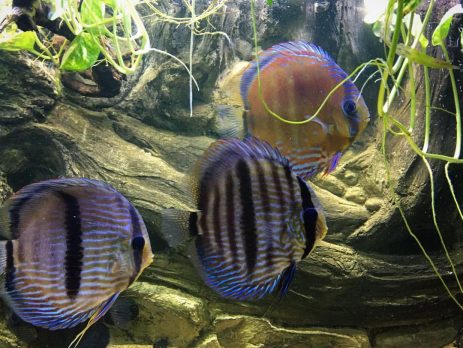
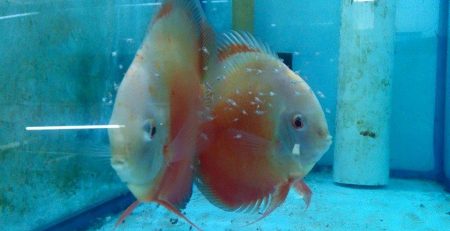
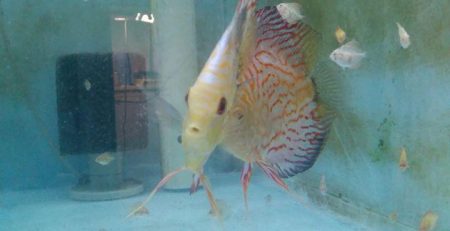

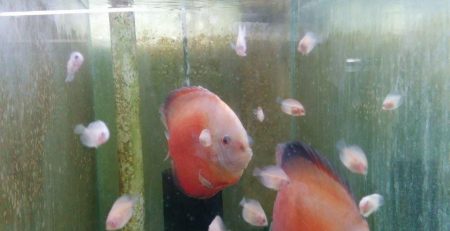
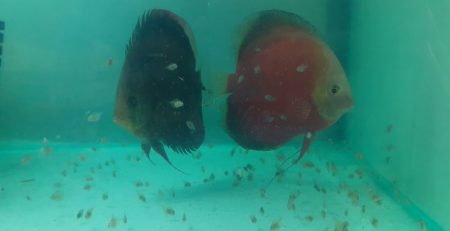
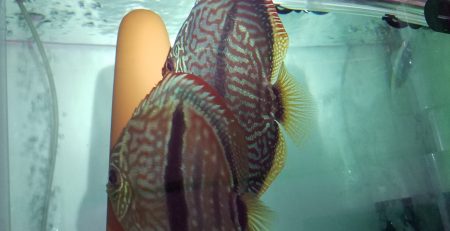

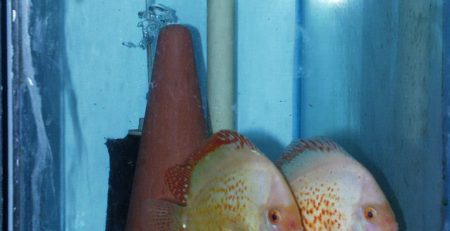
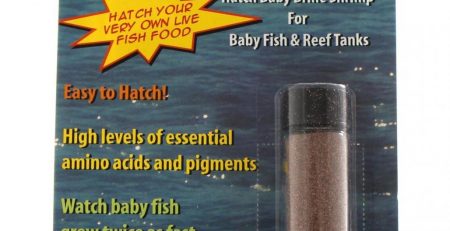
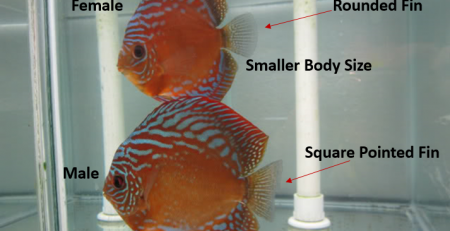
Leave a Reply
You must be logged in to post a comment.